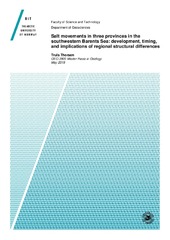| dc.contributor.advisor | Knutsen, Stig-Morten | |
| dc.contributor.advisor | Rydningen, Tom Arne | |
| dc.contributor.advisor | Krogh Johansen, Sondre | |
| dc.contributor.author | Thorsen, Truls | |
| dc.date.accessioned | 2020-05-15T15:10:09Z | |
| dc.date.available | 2020-05-15T15:10:09Z | |
| dc.date.issued | 2019-05-15 | |
| dc.description.abstract | This study has investigated salt movements in the Nordkapp Basin, on the Loppa High (Svalis Dome) and on the Bjarmeland Platform (Samson- and Norvarg domes). The aim is to discuss how differences in salt growth potentially relates to the structural evolution of - and differences between - these three provinces.
Evaluation of seismic 2D- and 3D data together with well correlation, allowed a regional stratigraphic framework to be established for the Permian-Quaternary succession. Four stratigraphic units were defined: Lower Triassic, Lower to Middle Triassic, Middle Triassic-Jurassic and Cretaceous-recent. Thickness variations and reflection configurations within these units, together with salt morphology, documented the timing of salt growth.
In the Nordkapp Basin, several phases of salt growth occurred throughout the Triassic, a period usually referred to as tectonically quiet in the southwestern Barents Sea. Extensional forces locally lead to subsidence and faulting/steepening of the basin margins. A regional extensional event lead to renewed salt growth during the Cretaceous, before Cenozoic regional compression squeezed the diapirs, resulting in a final growth phase. At the Svalis Dome, a salt pillow grew during the Early to Middle Triassic-Jurassic. Later uplift and erosion of the dome resulted in renewed growth and diapirism. Little or no salt movements are observed on the Samson- and Norvarg domes during the Mesozoic, but Cenozoic compression appears to have mobilized the salt.
The main differences in salt growth between the three provinces seem to relate to the different structural settings; in the Nordkapp Basin, diapirs grew already in the Triassic possibly due to extensional forces in and adjacent to the basin. On the Svalis Dome, the salt growth seems to relate to a large degree of uplift of the Loppa High. At the Bjarmeland Platform, a late initial growth stage reflects a tectonically stable environment until Cenozoic regional compression mobilized the salt. | en_US |
| dc.identifier.uri | https://hdl.handle.net/10037/18306 | |
| dc.language.iso | eng | en_US |
| dc.publisher | UiT Norges arktiske universitet | en_US |
| dc.publisher | UiT The Arctic University of Norway | en_US |
| dc.rights.accessRights | openAccess | en_US |
| dc.rights.holder | Copyright 2019 The Author(s) | |
| dc.rights.uri | https://creativecommons.org/licenses/by-nc-sa/4.0 | en_US |
| dc.rights | Attribution-NonCommercial-ShareAlike 4.0 International (CC BY-NC-SA 4.0) | en_US |
| dc.subject.courseID | GEO-3900 | |
| dc.subject | VDP::Mathematics and natural science: 400::Geosciences: 450::Petroleum geology and petroleum geophysics: 464 | en_US |
| dc.subject | VDP::Matematikk og Naturvitenskap: 400::Geofag: 450::Petroleumsgeologi og -geofysikk: 464 | en_US |
| dc.subject | Nordkapp Basin | en_US |
| dc.subject | Nordkappbassenget | en_US |
| dc.subject | Svalis Dome | en_US |
| dc.subject | Svalisdomen | en_US |
| dc.subject | Samson Dome | en_US |
| dc.subject | Samsondomen | en_US |
| dc.subject | Norvarg Dome | en_US |
| dc.subject | Norvargdomen | en_US |
| dc.subject | Salt tectonics | en_US |
| dc.subject | Salttektonikk | en_US |
| dc.title | Salt movements in three provinces in the southwestern Barents Sea: development, timing, and implications of regional structural differences | en_US |
| dc.type | Master thesis | en_US |
| dc.type | Mastergradsoppgave | en_US |


 English
English norsk
norsk
